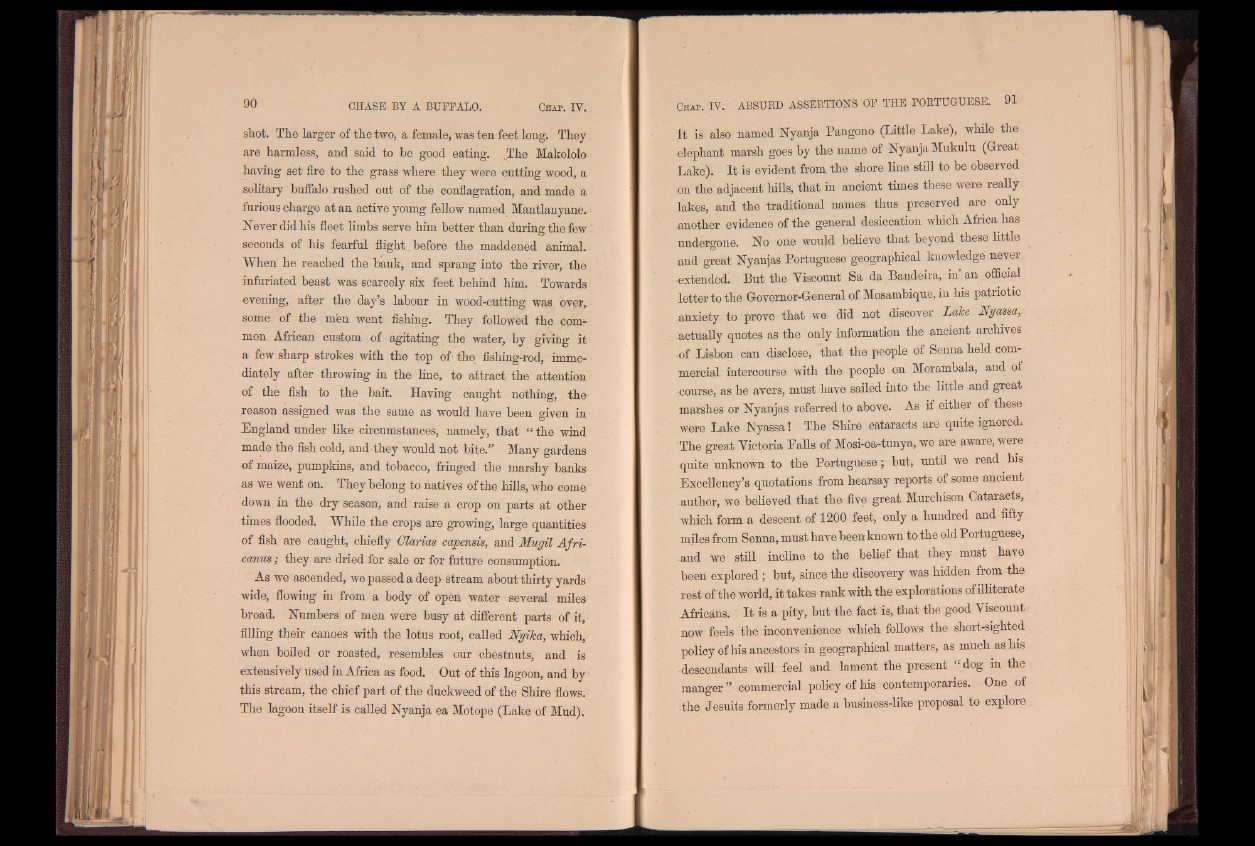
shot. The larger of the two, a female, was ten feet long. They
are harmless, and said to be good eating. The Makololo
having set fire to the grass where they were cutting wood, a
solitary buffalo rushed out of the conflagration, and made a
furious charge at an active young fellow named Mantlanyane.
Never did his fleet limbs serve him better than during the few
seconds of his fearful flight before the maddened animal.
When he reached the bank, and sprang into the river, the
infuriated beast was scarcely six feet behind him. Towards
evening, after the day’s labour in wood-cutting was over,
some of the men went fishing. They followed the common
African custom of agitating the water, by giving it
a few sharp strokes with the top of the fishing-rod, immediately
after throwing in the line, to attract the attention
of the fish to the bait. Having caught nothing, the
reason assigned was the same as would have been given in
England under like circumstances, namely, that “ the wind
made the fish cold, and they would not bite.” Many gardens
of maize, pumpkins, and tobacco, fringed the marshy banks
as we went on. They belong to natives of the hills, who come
down in the dry season, and raise a crop on parts at other
times flooded. While the crops are growing, large quantities
of fish are caught, chiefly Clarias capensis, and Mugil Afri-
eanus; they are dried for sale or for future consumption.
As we ascended, we passed a deep stream about thirty yards
wide, flowing in from a body of open water several miles
broad. Numbers of men were busy at different parts of it,
filling their canoes with the lotus root, called Nyika, which,
when boiled or roasted, resembles our chestnuts, and is
extensively used in Africa as food. Out of this lagoon, and by
this stream, the chief part of the duckweed of the Shire flows.
The lagoon itself is called Nyanja ea Motope (Lake of Mud).
I t is also named Nyanja Pangono (Little Lake), while the
elephant marsh goes by the name of Nyanja Mukulu (Great
Lake). I t is evident from the shore line still to be observed
on the adjacent hills, that in ancient times these were really
lakes, and the traditional names thus preserved are only
another evidence of the general desiccation which Africa has
undergone. No one would believe that beyond these little
and great Nyanjas Portuguese geographical knowledge never
extended! But the Yiscount Sa da Bandeira, in’ an official
letter to the Governor-General of Mosambique, in his patriotic
anxiety to prove that we did not discover Lake Nyassa,
actually quotes as the only information the ancient- archives
•of Lisbon can disclose, that the people of Senna held commercial
intercourse with the people on Morambala, and of
course, as he avers, must have sailed into the little and great
marshes or Nyanjas referred to above. As if either of these
were Lake Nyassa! The Shire cataracts are quite ignored.
The great Victoria Falls of Mosi-oa-tunya, we are aware, were
quite unknown to the Portuguese; but, until we read his
Excellency’s quotations from hearsay reports of some ancient
author, we believed that the five great Murchison Cataracts,
which form a descent of 1200 feet, only a hundred and fifty
mjles from Senna, must have been known to the old Portuguese,
and we still incline to the belief that they must have
been explored; but, since the discovery was hidden from the
’ rest of the world, it takes rank with the explorations of illiterate
Africans. I t is a pity, but the fact is, that the good Yiscount
now feels the inconvenience which follows the short-sighted
policy of his ancestors in geographical matters, as much as his
descendants will feel and lament the present “ dog in the
manger ” commercial policy of his contemporaries. One of
the Jesuits formerly made a business-like proposal to explore